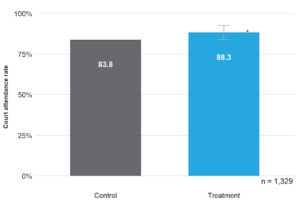When defendants miss a court appointment, many things can happen. Most of these are bad.
It’s bad for the police and the courts because they need to contact the defendant and reschedule, which takes up valuable time. It’s bad for defendants who may be arrested and are more likely to have negative experiences with police and the courts. This can entrench them in the justice system. And it’s bad for victims, who deserve the closure and safety that should come from a court decision.
The last 5 years have shown that behavioural science can get people to show up at court appointments. BIT’s early work in Australia helped defendants understand and remember what they have to do when they have a court appointment. In one study with the New South Wales Behavioural Insights Unit (BIU) we sent text reminders to domestic violence defendants the day before their court session, which led to a four percentage point increase in attendance.
In another intervention, we worked with the BIU to redesign legal notices for domestic violence defendants to remove the legal jargon and boost defendants’ understanding and memory of what they have to do. Although our redesign was guided by extensive qualitative research we were not able to evaluate the impact of the new notices when they were rolled out across New South Wales in 2016.
More recently, Drs Alissa Fishbane, Aurelie Ouss and Anuj Shah redesigned the New York City summons form for low-level offences, which led to a 5 percentage point increase in attendance. The work by Fishbane, Ouss and Shah extended the traditional way of thinking about non-attendance — that people skip court because they aren’t deterred by existing penalties — by taking a more behavioural lens. Instead they argue that simple human error can make people miss court. The results from their trial give credence to this theory.
There is a suite of reasons people don’t attend
However, in a recent article Professor Issa Kohler-Hausmann argues there are even more reasons defendants can fail to attend. She points out defendants may know they have to go to court but fail to do so for a number of societal reasons, including fear, mistrust of the legal system, lack of time, and a lack of resources.
A recent trial in Aotearoa New Zealand further highlights other reasons people don’t attend. We worked with the Evidence Based Policing Centre at New Zealand Police to encourage people to attend court after receiving a police bail notice.
We created a new police bail notice, by removing unnecessary legal jargon and putting the most important information at the top of the notice. We also tried to improve people’s comprehension of the notices by reducing their required reading age by 3 years, from 12 years old to 9 years old.
We then partnered with 6 police stations throughout New Zealand to test the impact of the new notice with a Randomised Controlled Trial (RCT). The new notices increased court attendance by 4 percentage points— from 84% to 88%. If scaled nationwide, this would mean around 1,600 more defendants would attend court each year.
Effect on the court attendance rate

What our results show
The results from the RCT add to the emerging evidence that small changes can improve memory and understanding and thereby boost court attendance, building on the work by Fishbane, Ouss and Shah. However, we bolstered this RCT with a number of interviews to understand some of the broader factors at play.
This qualitative work — where we partnered with Behavioural Science Aotearoa to interview 7 defendants and survey 89 custody staff — supports Kohler-Hausmann’s argument that there is a broader set of reasons why people can fail to attend than them strictly choosing not to attend or human error. We’ve listed three common reasons below, but there are likely to be more that our interviews did not uncover.
Transport barriers were identified by a number of interviewees. One defendant was new to the city and couldn’t find transport, while another was in custody because she’d missed court due to the 1.5 hour travel time. Another reason was childcare. Several defendants had to find someone to look after their children, which could lead to a missed appointment if no one was free.
Finally, waiting times at court were also identified. Many defendants showed up on time, only to wait several hours because the courts were busy. This created frustration, decreased trust, and made defendants less likely to appear again in the future. This was also recognised by the court staff, as shown by this quote:
“Why do we expect people to behave differently to us? Would you sit around all day waiting for your session? Sometimes we expect the defendant to do things we couldn’t do ourselves.” — Court staff member
Fortunately there are ways to overcome these barriers. The next step in boosting court attendance may be to build community support, and/or change how staff interact with defendants. Tapping into community support could help with transport, childcare and other barriers. Our fieldwork also suggests improving the interactions between staff and defendants could increase trust in the system, whether at arrest, while in custody, or at court
However, this does not mean that some of the factors that Fishbane and her colleagues pointed out do not matter. Our intervention was targeted at some of the factors that they highlighted and our intervention was effective. It is just that a more holistic approach may make further gains.
This project was funded by the New Zealand Police. We would like to thank Simon Williams, Cameron Dewe, Claire Falck, Sunita Singh and Matthew Davies for their support and advice. In the bar chart, the asterisk denotes that the p-value from our statistical analysis is less than 0.05, and the grey bar shows the 95% confidence interval. Full details will be shown in a forthcoming academic paper.






